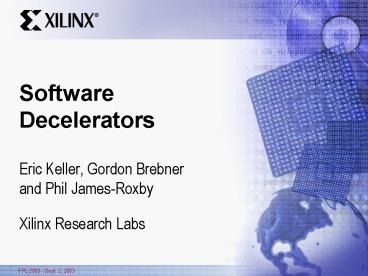Software Decelerators PowerPoint PPT Presentation
Title: Software Decelerators
1
Software Decelerators
- Eric Keller, Gordon Brebner and Phil James-Roxby
- Xilinx Research Labs
2
Talk Outline
- Background
- Software Decelerators
- Case Study Finite State Machines
- Results
- Conclusions
3
Modern Platform FPGA
4
Hardware Accelerator
- Processor-Centric
- Algorithms executed on processor
- key functions performed by hardware
- Goal Increase overall performance
JPEG2000
Processor
Mem
DWT
Tier 1 Coder
RCT
5
Motherboard On A Chip
- Processor running an operating system
- Common board peripherals on FPGA
- Ethernet MAC
- SVGA
controller
6
Logic-centric viewpoint
- Consistent with an interface-centric view that is
appropriate for reactive systems - highly
relevant for future ambient intelligence/ubiquitou
s computing - Processors have no special status in systems, and
indeed play only a secondary role as function
units - Explicit hardware-software co-design becomes
lesser issue - certainly no top-level
partitioning - Hardware accelerators of processor-centric model
are inverted and replaced by software
decelerators
7
Software Decelerators
- Algorithms are executed in logic
- Processor executes software to perform one or
more services for programmable logic
PPC
outputs
inputs
8
Motivation
- Emergence of platform FPGAs
- To increase overall system quality
- by making use of services provided by processor
- Ease of designing a complex function
- Offload non time-critical logic
- to achieve a better partition (e.g. saving area)
- Offload corner cases
- e.g. in MIR IPv4 packets handled in logic, IPv6
handled in processor
9
Goals
- Overall area consumed by software decelerator
should not be greater than logic counterpart - Interfacing logic should consume minimal logic
- Interface should shield logic from processor
- and vice versa
- Provide timing and resource usage information
- Implementation neutral method to capture design
10
Example finite state machines
- Implement a general class of sequential functions
that are recognizable in digital designs - Processor determines next state and state outputs
to meet schedule determined by logic-based system - possibility to support multiple state machines
Hardware platform
FSM decelerator generator
Graphical Representation
Textual Representation
Software
Timing report
11
Design Entry
- Graphical front end
- e.g. StateCAD
- Textual intermediate representation
- XML to support many design entry methods
- Define interface
- Define state
ltvariablesgt ltvariable nameop dirin
width4/gt lt/variablesgt ltstate
namestateADDgt lteqnsgt lteqn lhsout0
rhsin1in2/gt lt/eqnsgt lttransitionsgt lttran
nextstate1/gt lt/transitionsgt lt/stategt
12
Logic-Processor Interface
- Rest of system doesnt see processor signals
- Choice of interface
- PowerPCs native busses PLB, OCM, DCR
- With only two nodes, optimizations are possible
- interface logic always being addressed
- No need for arbiter
PowerPC
13
Clocking
- Polling/Interrupt on external clock
- processing time for state must be less than clock
period - processor uses polling to detect clock edges
- clock edge causes an interrupt
- Software Generated
- processor generates clock pulse using a memory
mapped circuit - allows different states to take different
processing time
14
Software Design
- General case is complex requiring timing analysis
- Assembly code generation
- each state has same structure (clock/reset,
equations, transitions) - Execute out of cache
- predictable memory accesses
- Accurate timing generation
- count the exact number of cycles it will take for
each state and transition
15
Results Resource Usage
Ratio is the area of the decelerator as a
percentage of area consumed by a logic
implementation
16
Results Performance
17
Conclusions
- Software decelerators
- through example of FSM based design methodology
- extendable to other functions
- can provide an increased overall system quality
- Methodology applicable to subset of designs
- achievable speeds vary with characteristics of
FSM - I/O takes a lot of processing time
18
Future Work
- Further study implications of logic centric model
- Automatic selection and synthesis of
logic-processor interfaces - Characteristics of hard/soft processors
- e.g. I/O takes large percentage of time
- FSM based architectural components
- Domain-specific high-level design entry and tools

